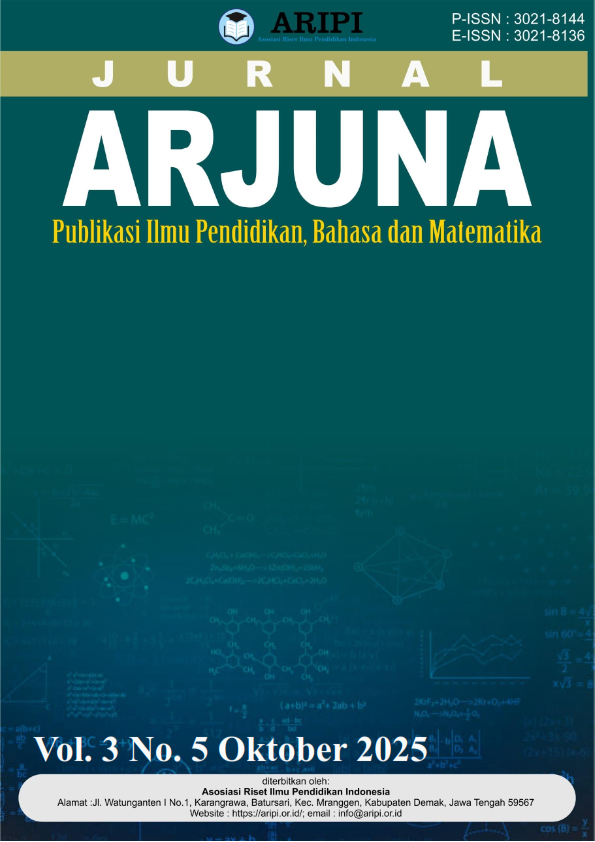Peran Guru IPS dalam Meminimalisasi Risiko Negatif Media Sosial Tiktok pada Siswa Kelas VIII MTs Darul Falah Sumbergempol
DOI:
https://doi.org/10.61132/arjuna.v3i5.2322Keywords:
IPS, Minimizing, MTs Darul Falah Sumbergempol, Negatuve Riks of TikTok, Social Studies TeacherAbstract
This study aims to investigate the role of social studies teachers in mitigating the negative impacts of TikTok usage among eighth-grade students at MTs Darul Falah Sumbergempol. With the rapid rise of social media use among adolescents, platforms like TikTok pose both opportunities and challenges, especially within educational and religious environments such as madrasas. A descriptive qualitative approach was adopted in this study, utilizing data collection techniques such as observation, interviews, and documentation. The research subjects included social studies teachers and eighth-grade students who were active users of TikTok outside school hours. Findings revealed that the majority of students used TikTok extensively in their free time, often engaging in content consumption and trend participation for prolonged periods. The negative risks identified included a decline in academic focus, adoption of slang and behaviors inconsistent with madrasa values, and increased susceptibility to peer pressure. In response, social studies teachers played a pivotal role in addressing these issues by integrating digital literacy concepts into classroom instruction, promoting the creation of positive and educational content, and fostering open communication with parents to monitor usage outside school. These strategies contributed to increased student awareness of the potential harms of uncritical social media use. However, the study also highlighted ongoing challenges, such as institutional gadget restrictions in Islamic boarding school environments and the extended duration often required to shift entrenched behaviors and digital habits. The study concludes that social studies teachers, when supported by a collaborative framework involving parents and school policies, can significantly influence students' digital behavior. Strengthening media literacy education and promoting critical thinking are essential steps toward cultivating responsible and ethical social media use among adolescents in religious educational settings.
Downloads
References
Ahmad Haidar, G., Nazli Nur Fadilah, W., Nabila Yusuf, Z., Haura Shafa, D., Alghifari Binadibu, M., & Bahasa Arab, P. (2023). Pengaruh Penggunaan Media Sosial Tiktok terhadap Karakter Siswa Kelas IXB SMPN 29 Bandung. Jurnal Pendidikan Tambusai, 7(3), 27008–27013. https://jptam.org/index.php/jptam/article/view/10980
Digital 2024: 5 billion social media users. (2024). We Are Social. https://wearesocial.com/id/blog/2024/01/digital-2024-5-billion-social-media-users/
Gayatri, G., Rusadi, U., Meiningsih, S., Mahmudah, D., Sari, D., & Nugroho, A. C. (2015). Digital Citizenship Safety Among Children and Adolescents in Indonesia. Jurnal Penelitian Dan Pengembangan Komunikasi Dan Informatika, 6(1), 1–18.
Indonesia, U. (2021). Digital Safety Survey of Indonesian Teens. UNICEF Indonesia.
Komang, N., Maharani, T., Suastika, I. N., Agung, A., Dewi, I., & Utami, A. (2025). Pemanfaatan Media Sosial TikTok dalam Kehidupan Siswa Sekolah Dasar dan Implikasinya Terhadap Pembentukan Karakter Disiplin Utilization of TikTok Social Media in the Lives of Elementary School Students and Its Implications for Discipline Character Buildin. Jurnal Pendidikan, Ilmu Sosial, Dan Pengabdian Kepada Masyarakat, 5(1), 545–552. https://jurnal.permapendis-sumut.org/index.php/edusociety
Kusuma, C. D. N., Prajiko, R., & Chumaeson, W. (2024). Transformasi Perilaku Sosial Remaja Era Digital: Penggunaan Tiktok Di Kalangan Remaja. KOMUNITAS: Jurnal Ilmu Komunikasi, 10(2), 18–25.
Mendoza, M. D., Olnes Yosefa Hutajulu, Lubis, A. R., Rahmadani, R., & Putri5, T. T. A. (2024). Pengaruh Penggunaan Media Sosial terhadap Prestasi Akademik Mahasiswa. Pubmedia Jurnal Penelitian Tindakan Kelas Indonesia, 1(3), 10. https://doi.org/10.47134/ptk.v1i3.433
Muyasaroh, J., & Najicha, F. U. (2023). Transformasi Pendidikan Kewarganegaraan: Eksplorasi Peran Dan Dampak Media Sosial Pada Siswa Dalam Konteks Globalisasi. Researchgate. Net (December), December.
Omar, B., & Dequan, W. (2020). Watch, share or create: The influence of personality traits and user motivation on TikTok mobile video usage. International Journal of Interactive Mobile Technologies, 14(4), 121–137. https://doi.org/10.3991/IJIM.V14I04.12429
Pardede, P. (2019). Menjadi Guru Zaman Now & Cara Pembelajaran Siswa Memasuki Era Industri 4.0. Conference Paper, July, 0–19. https://www.researchgate.net/profile/Parlindungan-Pardede/publication/334230917_Menjadi_Guru_Zaman_Now_Cara_Pembelajaran_Siswa_Memasuki_Era_Industri_40/links/5d1dfe5aa6fdcc2462bf9cdd/Menjadi-Guru-Zaman-Now-Cara-Pembelajaran-Siswa-Memasuki-Era-Industri-40.
Prahesti, V. D. (2022). Meningkatkan Profesionalisme Guru di era Society 5.0 (Issue March).
Salabilla, A., & Rizkiah, M. (2024). Pengaruh Platfrom Tiktok Terhadap Minat Belajar Siswa Sekolah Dasar The Influence of the Tiktok Platfrom on Elementary School Students ’ Learning Interests. Action Research Journal Indonesi, 6(4), 570–580.
Sapriya, S. (2017). Pendidikan IPS: Konsep dan Pembelajaran (8th ed.). PT. Remaja Rosdakarya.
Social, W. A. (2023). Digital 2023: Indonesia. We Are Social. https://wearesocial.com/insights/digital-2023-indonesia
Solehudin, H. (2024). Book Chapter - Pendidikan Inovatif (Issue January).
Teens , Social Media and TikTok has established itself as one of the top on line platforms for. (2022). Audgust.
Downloads
Published
How to Cite
Issue
Section
License
Copyright (c) 2025 Jurnal Arjuna : Publikasi Ilmu Pendidikan, Bahasa dan Matematika

This work is licensed under a Creative Commons Attribution-ShareAlike 4.0 International License.






